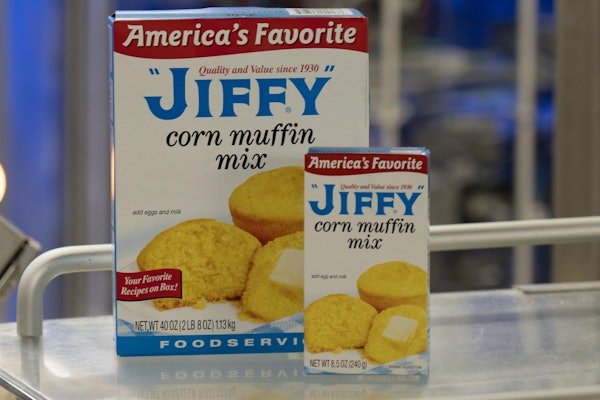Note: This article is a follow up to February’s Packaging World column, Stretch Wrapping for Optimal Load Containment, available at pwgo.to/5506.
There are two types of stretch film: cast and blown. The names refer to the extrusion process. The cast process is the simpler. Molten resin is extruded through a slot die in a continuous, single sheet, which travels horizontally over chill rollers before being wound around a core.
With the blown process, extrusion is through a circular die, resulting in a tube, which is pulled up vertically while being expanded by air. At the top of its travel, the tube is collapsed. Traveling downward, the tube’s sides are trimmed, making twin sheets, which are wound onto separate cores.
Each process impacts its film’s properties and cost. Cast, per given gauge (thickness), costs less. It has the better clarity and unwinds more quietly. Blown, per given gage, is stronger, providing greater resistance to tear and puncture, and has greater memory (resistance against becoming slack). The aforementioned don’t exhaust all the differences, but that’s not the aim; rather, what’s to be appreciated is that differences only become relevant when considered systematically against relevant variables.
It starts with the type of load to be contained. The load’s ability to withstand the containment force depends on the combined contributions of all levels of packaging, from primary to tertiary. Also to be factored are the load’s physical descriptors e.g. size and weight. Add considerations about configuration for even with homogenous, symmetrical loads, pallet patterns affect stability.
All companies know the structure of their supply chains. Far fewer, however, know as much as they need to about the when, where, and intensities of the physical forces imposed during material handling, transportation, and warehousing. How many times a load is handled is important because each handling is an opportunity for damage. As for transportation, the inherent forces of shock, vibration, and compression can work ill effects. A warehouse, contrary to misconceptions, is not static, but a hub of activity, with loads constantly coming and going. Furthermore, stacked loads can become misaligned, stressing load containment.
Moving the discussion to stretch wrapping machinery, considerations include acquisition price, maintenance, energy consumption, floor footprint, and operator-friendliness. The interdependence between machine and film, however, is more reflected in the speed, efficiency, and effectiveness in which loads are wrapped.
A film given to breaking, for example, requires repeatedly stopping the machine. As another example, the width of the film affects the overlap and the number of revolutions needed to complete a load. Yield is a measurement of how many loads a given amount of film can wrap, thereby impacting cost per load. Yield, in turn, depends on how much the film can be stretched during application. Incidentally, some machines have a pre-stretch feature.
The optimal marriage between film and machine achieves the shortest cycle time, consistent with acceptable load containment. It’s a point arrived at after trials and tweaking—after which, the results should be the stuff of standard operating procedures (SOPs). That way, the success of actions such as start-up, machine calibration, and quality checks become measurable and repeatable, instead of being left to operator’s discretion.
A bare-bones way of specifying stretch film is gauge, process, and material—for example: 60 gauge/cast/LLDPE. Cast and blown are dedicated processes, meaning the equipment for one can’t be converted to the other. Materials, on the other hand, can vary across monolayers, coextrusions, and hybrids. Gauge, however, is the easiest of the three variables to manipulate. That’s why processors—spurred by sustainability—are offering films of lower gauges, promoted as equivalents to higher gauges. Downgauging, nonetheless, is not automatically the best option, and should be evaluated in terms of how it figures within a systems approach.
An essential realization is that costs are not the be-all and end-all under a systems approach. It shouldn’t be about costs, per se, but about cost-effectiveness, getting the most bang for the buck.
Further regarding costs, there are off-setting benefits. When goods become damaged and unsellable, squandered become the materials, labor, and overhead incurred in their production, in addition to those incurred throughout the supply chain. The other side of that coin is foregone profits. On a related note, a company that consistently achieves adequate load containment is valued by other members of the supply chain, thereby fostering goodwill and continued business relations.
Worth mentioning is the human toll that poor load containment can inflict. Injuries, even fatalities, can befall people in the vicinity of loads that come apart. Whether redress is sought through workers’ compensation or through civil litigation, it can be a costly proposition for the involved company, in addition to a hit against that company’s reputation for safety.
In summary, with so many competing, often conflicting, factors to consider, a systems approach to load containment is the only way to go.
























